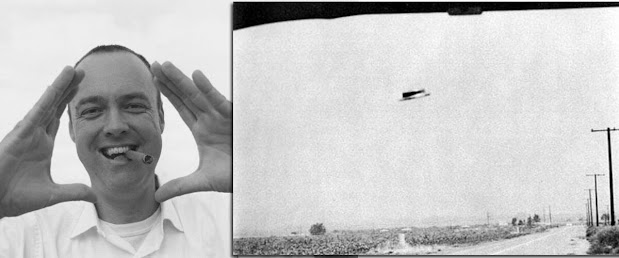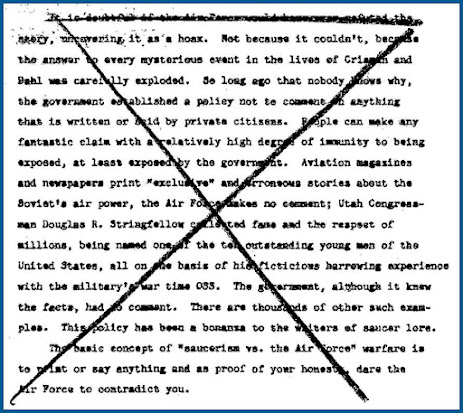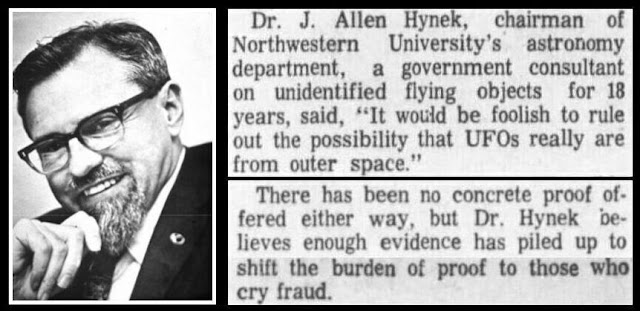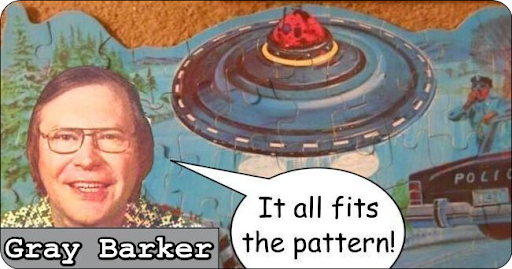Especially after 1957, the Air
Force did declare some UFO cases hoaxes, but they were not in
the business of exposing the hoaxer themselves or of punishing them. If the
hoaxer committed a crime, that was up to local law enforcement or the FBI to
press charges. The number of UFO hoaxers who have faced justice by the law is
very small. Below is a partial list of the few that paid for their crimes, as
well as some examples of those that escaped prosecution.
1947: The Maury Island Hoax
Shortly after the news of Kenneth Arnold's famous sighting in June 1947, Harold Dahl and Fred Crisman reported an amazing story of seeing giant doughnut-shaped flying discs near Maury Island in Puget Sound, Washington.
 |
| Fred Crisman and a depiction of his story. |
Captain Edward J. Ruppelt covered the investigation in his 1956 book, The Report on Unidentified Flying Objects. Ruppelt's chapter, "The Era of Confusion Begins," stated that the government had thought seriously of prosecuting hoaxers Dahl and Crisman:
"At the last minute it was decided, after talking to the two men, that the hoax was a harmless joke that had mushroomed, and that the loss of two lives and a B-25 could not be directly blamed on the two men. ...By the time the facts were released they were yesterday's news."
Dahl and Crisman avoided charges and prosecution for their hoax.
1949/1950: The Aztec Crashed Saucer Hoax
Silas Newton and Leo Gebauer were partners in the Aztec UFO hoax which was the basis for Frank Scully's 1950 book, Behind the Flying Saucers. The saucer story was the backdrop for an oil fraud scheme: the duo was selling "doodlebugs," phony mineral detectors that they claimed used magnetic technology from the Venusian saucers.
Newton and Gebauer were charged with fraud, and found guilty and convicted in 1953, but for selling the bogus devices, not the saucer hoax itself. The two managed to dodge any prison time.
1953:
The Little Green Man Hoax
On July 8, 1953, three
young men, Edward Watters, Tom Wilson, and Arnold Payne claimed
their truck hit and killed a small alien from a flying saucer. They had
the body, and subsequent examination by a veterinarian revealed the
"Martian" was a monkey that Watters had killed and mutilated. The men
confessed it was a prank stemming from a $10 bet that Watters could get his
name in the newspaper.
Incidentally, the case has the only "alien autopsy" mentioned in Air Force files.
A jurisdictional technicality prohibited Watters from being charged for animal cruelty, but he plead guilty to a charge of highway obstruction and was fined $40. For more details see, the Project Blue Book Case File.
1958: The Little Blue Man
For several weeks in early 1958 motorists around Elkton, Michigan, reported seeing a blue man on or near the roadway, possibly a being from outer space. Witnesses accounts varied, describing the creature as two to ten feet tall, and one said, "It ran faster than any human." The stories persisted, and when a busload of kids witnessed the blue man, their parents pressured the authorities to investigate. Facing the the heat from the law, the "alien" turned himself in.
 |
| Elkton Review April 24, 1958 |
The Little Blue Man was the creation of Don Weiss, Jerry Sprague and LeRoy Schultz. The three created a glowing blue costume with blinking lights to look like a space visitor. They confessed to the police who were amused by the prank and left them off with a warning. For further details, see: Last surviving ‘Blue Man’ prankster amused by interest in tale six decades later, from the Huron Daily Tribune, Feb. 25, 2022.
The
Crackdown on Saucer Swindlers
While the law didn't care much about typical hoaxes, there were some serious saucer-related swindles that drew their attention. In
the late 1950s, the Air Force's Office of Special Investigations (OSI) began
informing the FBI about saucer-related crimes. Major James F. Byrne (from the
Pentagon’s Press Desk) sent a memo on May 10, 1957:
“The subject of U.S. persons using the UFO hysteria for personal gain has been informally brought to the attention of the FBI. Documented cases where illicit or deceptive devices or methods are used by individuals to arouse public interest in UFOs should be made available to the FBI through the OSI. This subject is being studied by AFOIN-X1 and further development will be brought to your attention."
The result? The FBI checked up on some sketchy characters.
There
were several scoundrels scamming saucer fans, and three were caught and
convicted from 1957 to 1961, most notably Harold J. Berney, Otis T. Carr, and Reinhold O. Schmidt.
Hard Time was a Rarity
Getting back to typical UFO hoaxes, police were often involved in local UFO investigations, but seldom punished the perpetrators of false reports. Below is a rare exception, but take notice of the light penalty involved.1965: The Glassboro, New Jersey, Saucer Landing
Michael Hallowich or Hallowitz was fined $50 for hoaxing his Sept 4, 1964, sighting of a UFO landing, but it was suspended. He was just ordered to pay $10 in court costs.
Project Blue Book files contain the news story from the clipping above from the Philadelphia Evening Bulletin Jan. 19, 1965
Post-Project Blue Book
There was a lull in UFO activity following the closure of Project Blue Book, but things picked up in 1973 with the Pascagoula abduction case, and many phonies sprung up in its aftermath.
The NICAP UFO Investigator, Nov. 1973, “Flap Yields High Noise Level” covered several of the 1973 hoaxes, including those below.
1973: The Silver Saucerians
From
an Associated Press story, October 23, 1973:
'Little men in silver suits' fined by judge for their gag
JONESBORO, Ark. (AP) — Two men accused of "impersonating visitors from outer space" have been fined $25 each, plus $24.80 in court costs on charges of malicious mischief. Municipal Judge John States suspended 30-day jail sentences for the two — Stanley Burdyshaw, 18, and William Wilson, 21, both of Bono. State Trooper Daniel Oldham and a sheriff's deputy, Bill Finley, said about 20 motorists reported Sunday night that "little men in silver suits" were obstructing traffic on U.S. 63 near Bono. Oldham said he and Finley found the two standing at the edge of the highway "covered from head to toe" with aluminum foil. The motorists had complained that the "little men" had been jumping in front of cars, the officer said.
1973: The Delaware Saucer Landing
On Oct. 16, 1973, traffic backed up as drivers stopped to take a look to see if it was really a flying saucer landed on the hill by the road. When the police came they discovered it was a saucer-shaped circle of flashing lights powered by portable generator. The perps were five young volunteer firemen who had set it up as prank. Since the distraction could have caused a traffic accident they were arrested, but only charged with disorderly conduct.
 |
| An imaginative depiction from UFOs Flying Saucers #4, Nov. 1974 |
This concludes our sampling of UFO hoax-related crimes. In a future article, we’ll take a look at crimes committed while under the influence of ufology, from the comedic to the truly tragic.
. . .









































